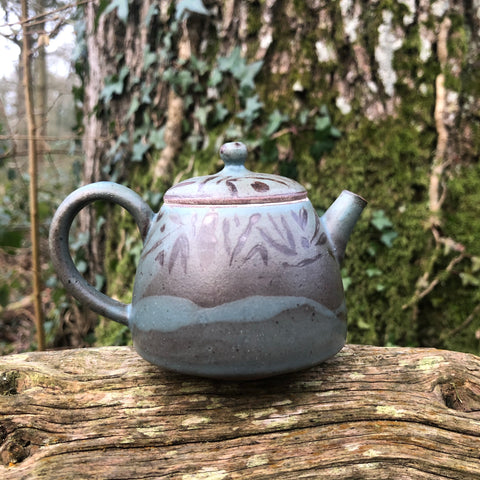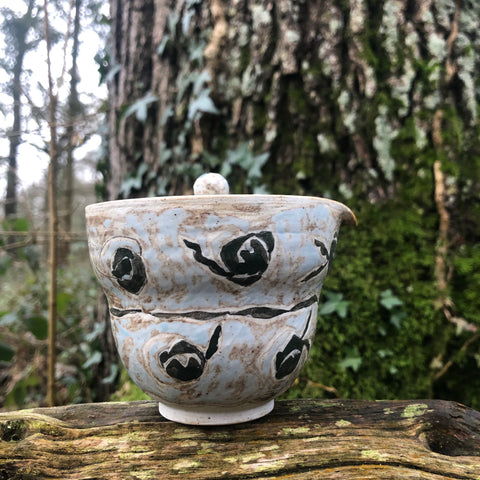120ml Terra-sigillata with silver paint decoration teapot [Seong Il Hong : Boseong, South Korea ]
120ml Terra-sigillata with silver decorations teapot
We are delighted to bring you a number of pieces from the studio of the talented South Korean potter Seong Il Hong. Rob last visited Seong Il and had the great pleasure of spending time in his studio in May 2019 and more recently Michelle visited in 2024

You can read more about Seong Il in our book tales of the tea trade an extract of which is below :-
THE CREATIVE CONNECTOR: SEONG IL HONG, POTTER, BOSEONG
Seong Il: ‘My passion is Onggi – traditional Korean earthenware pottery
that dates back to 4000–5000 BC [...] Onggi clay is rich in iron materials, which means it has a lot of air in it, which in turn is good for the storage of foods that you want to ferment.
‘Learning traditional Onggi pottery was the most important turning point in my pottery life. I left Seoul in 2000 and moved to Jeollanam-do Boseong, where I met my wife, who also came to study earthenware. Since moving here I have been making teaware. Tea culture is thriving in this area, along with Jeju Island and Hadong. Today, I run a teaware gallery, tea house and pottery studio. From this space I communicate with tea people and teaware lovers. I simply spend my days drinking tea with them and making pottery [..]
[...] ‘I love to work at the wheel. The work I do on the wheel while the clay is
wet is all about maximizing the properties of the clay. I like to be part of the change in the formation of the clay.

Seong Il gains inspiration for his wares from the long history of ceramics in Korea. 'Porcelain is a very pure material – when fired it is not porous, and it has a very “tight” finish like glass. This is the type of teaware we use for green tea, as it does not affect the character of the tea. In contrast, stoneware has a relationship with the tea and affects the taste. This is the type of teaware we use for Korean hwangcha and balhyocha. At my studio we make different types of stoneware and experiment with different types to get the right stability and profile for each pot. Since the pot will become part of the experience of the tea, we always taste the tea in the pots we make to see how the clay affects the flavour"
Looking to the future Seong Il is optimistic : 'Korean teaware has adopted both the technological advantage of Chinese and the elegant beauty of Japanese teaware. Fancy, but also functional. Efficient Korean teaware has a proper structure to allow the enjoyment of different kinds of teas, so I am sure that they will gradually achieve their true value as the time passes.’


![120ml Terra-sigillata with silver paint decoration teapot [Seong Il Hong : Boseong, South Korea ]](http://cominstea.com/cdn/shop/files/3D0ACF1A-0147-4DC9-89BB-0186EFCECAFC_1024x1024.jpg?v=1731847150)
![120ml Terra-sigillata with silver paint decoration teapot [Seong Il Hong : Boseong, South Korea ]](http://cominstea.com/cdn/shop/files/3D0ACF1A-0147-4DC9-89BB-0186EFCECAFC_grande.jpg?v=1731847150)
![120ml Terra-sigillata with silver paint decoration teapot [Seong Il Hong : Boseong, South Korea ]](http://cominstea.com/cdn/shop/files/A44F53BE-D9DA-46BE-A1FB-D32CF7CF881C_grande.jpg?v=1731847152)

![Master Zhang's Wood Fired 'Mirror' Teapot [Tai Chung Taiwan]](http://cominstea.com/cdn/shop/products/image_e06b6a92-b561-4bce-8624-6bb35da04d65_large.heic?v=1669370258)

![210ml Carved coloured pearl silver teapot [Seong Il Hong : Boseong, South Korea ]](http://cominstea.com/cdn/shop/files/61B2F7B0-B3D8-4072-930E-57CC8DC7D540_large.jpg?v=1731847946)